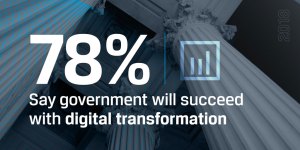
For real HR transformation, begin with the customer
As we move to a new generation of HR systems and to service delivery models that include more shared services, Jeff Neal says we have a perfect opportunity to get...
Best listening experience is on Chrome, Firefox or Safari. Subscribe to Federal Drive’s daily audio interviews on Apple Podcasts or PodcastOne.
This column was originally published on Jeff Neal’s blog, ChiefHRO.com, and was republished here with permission from the author.
It is no secret that the HR community is not typically viewed as the leader in customer service.
Inadequate resources devoted to training HR specialists and a focus more on compliance than customer service are generally accepted as chief causes of the problem. We should add to that list the shared systems and services that simply replicate rather than transform the problematic systems and service delivery models they replace.
ICF survey results
The Federal Digital 2018 Trends: Landing the Next Moonshot highlights three critical challenges that the federal government must prioritize to achieve the digital transformation that is required. The survey results are not limited to HR, but my focus for this post is on how the findings relate to delivering HR services. One encouraging finding is that 78 percent of respondents believe government will succeed with digital transformation.

That success will not be without challenges. Getting it right will require that government:
- Create a culture of innovation that supports iterative, ongoing progress,
- Prioritize the citizen experience, and
- Implement an integrated approach to digital transformation
The challenge that I believe is most critical for HR is the citizen/customer experience. An HR organization that is viewed as providing great customer service is not the norm.
As we move to a new generation of HR systems and to service delivery models that include more shared services, we have a perfect opportunity to get it right. Designing those systems and service delivery models around the customer is essential. In fact, the survey showed that 92 percent of respondents say agencies should focus on user experience vs. technology development.

The generation of large scale HR systems we use today was developed with much more of an inward focus. HR practitioners laying out requirements tended to focus more on what HR needed than what customers needed and wanted. The customer base of HR — primarily agency employees and job applicants — were left out of design considerations. In many respects the same thing applies to how HR services are delivered.
HR organizations have been designed to facilitate the internal flow of work, and with a focus more on what HR needs than what the customers need.
Hiring processes an example of disconnect
Hiring processes are driven in large part by OPM regulations, but that does not mean an agency has to torment the customer who wants to apply for or fill a job. The systems that applicants use could be far more accessible in terms of ease of use and functionality. The HR organizations that deliver those services can also be more accessible and far more focused on delivering a great citizen/customer experience.
My fear is that we will see a move from today’s legacy systems and HR offices to a new generation of technology and shared services that are no more customer-centric than what we have today. Rather than taking advantage of the opportunity to achieve real transformation, we will get no more than a technology upgrade and reshuffled HR organizations, with no real understanding of how customers are affected. We may see some attention paid to the user experience with the technology, but not on the overall customer experience with the HR organization and its people and processes.
HR is an ideal line of business to focus on a more inclusive customer experience approach rather than isolated pieces of technology and work processes. We should be asking what customers need and what they think. We should develop an organizational culture in HR that rewards customer-centric approaches, and we should engage in “journey mapping” to help HR practitioners walk in their customers’ shoes. If we do that, we may find we can create a next generation of HR service providers that can help customers in ways we would never see today.
We should also not forget that HR already plays a critical part in helping agencies implement new technology, processes and organizations. They do that by facilitating the hiring and development of the talent agencies need.
HR not considered valued partner
The survey showed that only 17 percent of respondents said HR would be among the most likely to provide useful input. That means that the need for HR transformation is even more critical. Without it, agencies may not be able to recruit, develop and retain the talent they need.
When I was hired as HR Director for the Defense Logistics Agency, we had a similar problem. The agency was beginning a billion-dollar modernization program, but agency leaders had no confidence that the HR organization could deliver. In fact, the task of leading the training required to implement the new technology and processes was given to the agency’s logistics operations organization. After we implemented sweeping changes in HR, including a move to a far more customer-centric approach to delivering HR services, the work was moved to the HR organization.
HR can transform itself into the vital player it needs to be, but it will require a very different approach that balances technology, human-centered design, change management, stakeholder engagement and deep analytics to understand the needs of customers in and out of government.
Jeff Neal is a senior vice president for ICF and founder of the blog, ChiefHRO.com. Before coming to ICF, Neal was the chief human capital officer at the Homeland Security Department and the chief human resources officer at the Defense Logistics Agency
Copyright © 2025 Federal News Network. All rights reserved. This website is not intended for users located within the European Economic Area.



